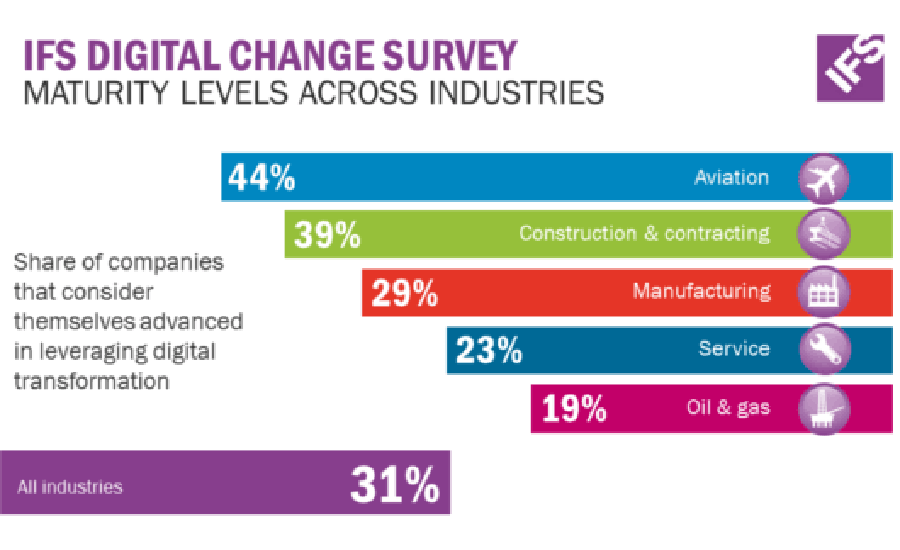Digital transformation is coming of age. In a recent Digital Change Survey of 750 professionals across a range of industries, 80% saw themselves as "enabled," "enhanced" or "optimized" to leverage digital transformation.
Even more impressively, 89% of respondents said they have "advantageous" or "adequate" funding in place for digital projects—a clear acknowledgment that the time of disruptive technologies is here and that the vast majority of firms are realizing they need to invest.
Conducted during the first six months of 2017, the survey was commissioned by IFS, a company that develops and delivers enterprise software for customers manufacturing and distributing goods, maintaining assets and managing service-focused operations. Respondents were equally represented from five industries: oil and gas, construction and contracting, manufacturing, aviation, and service providers. They came from a variety of companies differing in size from 1,000 to 10,000 or more employees, the majority being midsize companies with 5,000 to 9,999 employees.
But why are businesses investing? Where do they see the big profits? How successfully are they selling digital change throughout their organizations?
More than a quarter (27%) say digital transformation (DT) "makes them more competitive," giving them a vital differentiating edge; 29% see the main benefit as "accelerating innovation"; and 28% are in it for the "growth opportunities in new markets," the survey found.
Companies that are using digital transformation to ask far-reaching questions, such as how to gain a bigger share of the market or increase a product portfolio, are making the most of the technology's long-term, strategic opportunities. They are beginning to see how DT can create strategic differentiators from seemingly small tactical decisions, such as how often to service equipment.
But these companies are in the minority. The largest group in the survey, 47%, still see the main benefits of DT as "improving internal process efficiencies," which makes one wonder whether companies really see the full potential of what disruptive technologies can achieve.
Innovation can make or break a company, and study after study foregrounds innovation as a C-level priority. So, why doesn't it appear to be a driver for digital transformation?
Considering technology investments, it would seem the majority of funds are going toward making a company's internal processes more effective, thus failing to enable innovation. But it is too short-sighted to see "improved internal efficiency" as the key reason to explore DT. Indeed, that reason fails to exploit the strategic benefits and makes winning the understanding and commitment of staff more difficult.
Despite plenty of good news, the survey reveals that 42% of respondents still view "aversion to change" as the main barrier to digital transformation. Companies need to think carefully about how they position the so-called internet of things and other disruptive technologies, how they tell the story of why they are using them, and how they communicate the benefits to their entire workforce. Companies need to turn their data-phobe staff into data fans.
The most successful technology shifts are embraced from the bottom up as well as the top down. They're driven by people. The buy-in from staff is mission-critical. When a service engineer hears that predictive maintenance is going to be deployed, he or she may think, "That's going to put me out of a job." Companies need to communicate clearly and openly that DT offers new inspiration, working methods, and opportunities for growth and improvement for all.
Rather than citing "improving internal efficiencies," a company should stress how DT will help with big-picture, long-term strategy and how it will make the company more competitive, accelerate innovation and win growth opportunities in new markets.
Digital transformation is like many other big-change projects that are all about winning the hearts and minds of the people who are actually going to enter the data or use the system. It needs to be managed on a human scale.
We all understand that no amount of short-term savings will make our jobs or businesses more secure if the firm isn't staying competitive in the long term. Companies must paint the big picture, positioning digital change as strategic, not tactical, and inspiring, not invasive.
"Upskilling" and "Reskilling"
One in three of the surveyed companies are "unprepared to deal with the digital skills gap." Smart businesses already are spotting potential data candidates, such as the above service engineer. How can companies bridge the skills gap affordably, sustainably and creatively?
• Consider how your organizational structure needs to be developed to foster digital development. For large companies, there is the option of creating new departments dedicated to digital initiatives, "hothousing" analytic skills and nurturing them in-house.
• Conduct a digital competence inventory. There is a huge need for training staff in managing and analyzing data, and this need must be met for companies to succeed with digital initiatives. Establish what technology in your company is key for development. As part of this digital inventory, start identifying individual staff members who have the drive to "upskill."
• Properly develop skills. HR teams need to decide what current roles need to be developed and where new talent is needed. Bring in external trainers to provide new perspectives.
• Work together with local universities, both to attract talent and to influence the schools to focus their education programs in the right areas. Placement schemes offer undergraduates real-life programming experience, simultaneously growing the firm and the student. Apprenticeship schemes discover local talent and give them support and a place to grow.
Three Pillars for Success
There are three pillars to succeed with digital transformation: technology, investment and people. The technology aspect is often mastered most successfully, as it is driven by technology experts with clearly dedicated areas of responsibility. The main question is whether your company is focusing on the right technology to drive transformation at the right time. Do you want to be the pioneer taking risks or jump on the bandwagon when the technology is more mature?
Regarding investment, as we saw in the survey, companies think they are investing enough in digital transformation. But are they focusing on the right areas? The results indicate there is a heavy focus on process efficiencies, so there could be a need to steer toward more innovation-focused investments.
Finally, the human factor is most often forgotten in the DT process, not only in terms of talent but also with regard to communications. If more than 40% view "aversion to change" as the main barrier, employee communications is of the utmost importance. Make sure the staff knows the purpose of the DT change and how they will be affected.
So, it is high time to ask: Where does your company need to focus to build these pillars and be successful in its digital transformation?
Antony Bourne is vice president of global industry solutions at IFS.




